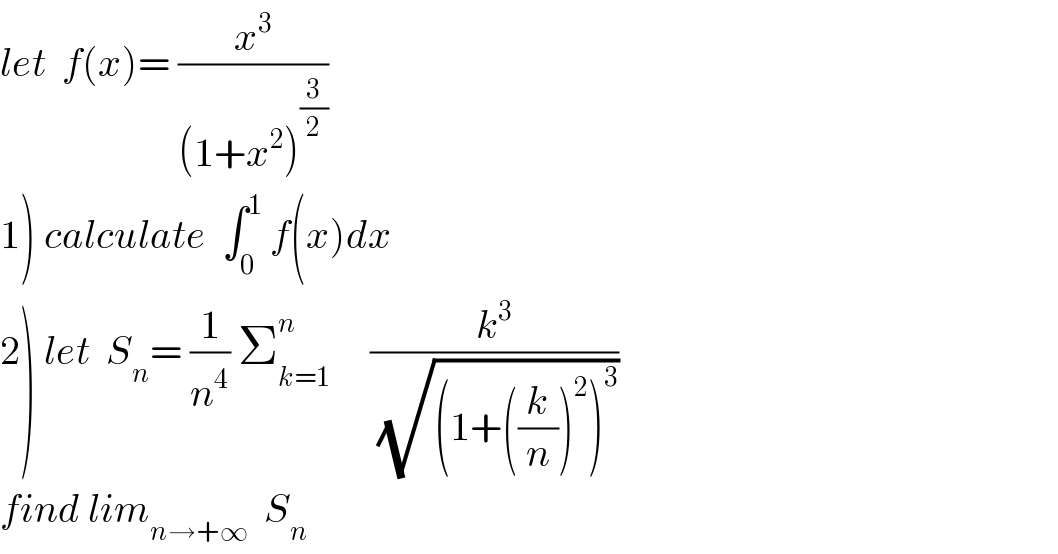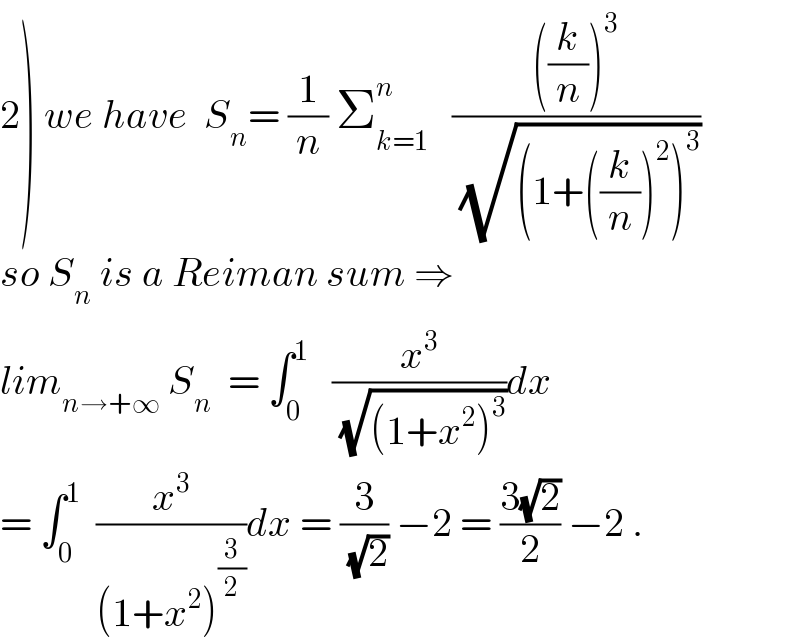
Question Number 40148 by maxmathsup by imad last updated on 16/Jul/18

$${let}\:\:{f}\left({x}\right)=\:\frac{{x}^{\mathrm{3}} }{\left(\mathrm{1}+{x}^{\mathrm{2}} \right)^{\frac{\mathrm{3}}{\mathrm{2}}} } \\ $$$$\left.\mathrm{1}\right)\:{calculate}\:\:\int_{\mathrm{0}} ^{\mathrm{1}} \:{f}\left({x}\right){dx} \\ $$$$\left.\mathrm{2}\right)\:{let}\:\:{S}_{{n}} =\:\frac{\mathrm{1}}{{n}^{\mathrm{4}} }\:\sum_{{k}=\mathrm{1}} ^{{n}} \:\:\:\:\:\frac{{k}^{\mathrm{3}} }{\sqrt{\left(\mathrm{1}+\left(\frac{{k}}{{n}}\right)^{\mathrm{2}} \right)^{\mathrm{3}} }} \\ $$$${find}\:{lim}_{{n}\rightarrow+\infty} \:\:{S}_{{n}} \\ $$
Answered by tanmay.chaudhury50@gmail.com last updated on 17/Jul/18

$${S}_{{n}} =\underset{{n}\rightarrow\infty} {\mathrm{lim}}\underset{{k}=\mathrm{1}} {\overset{{n}} {\sum}}\:\frac{\mathrm{1}}{{n}}\frac{\left(\frac{{k}}{{n}}\right)^{\mathrm{3}} }{\sqrt{\left\{\mathrm{1}+\left(\frac{{k}}{{n}}\right)^{\mathrm{2}} \right\}^{\mathrm{3}} }} \\ $$$${S}_{{n}} =\int_{\mathrm{0}} ^{\mathrm{1}} \frac{{x}^{\mathrm{3}} }{\sqrt{\left(\mathrm{1}+{x}^{\mathrm{2}} \right)^{\mathrm{3}} }} \\ $$$${t}=\mathrm{1}+{x}^{\mathrm{2}} \:\:\:{dt}=\mathrm{2}{xdx} \\ $$$$=\frac{\mathrm{1}}{\mathrm{2}}\int_{\mathrm{1}} ^{\mathrm{2}} \frac{\left({t}−\mathrm{1}\right).{dt}}{{t}^{\frac{\mathrm{3}}{\mathrm{2}}} } \\ $$$$=\frac{\mathrm{1}}{\mathrm{2}}\int_{\mathrm{1}} ^{\mathrm{2}} \left({t}^{\frac{−\mathrm{1}}{\mathrm{2}}} −{t}^{\frac{−\mathrm{3}}{\mathrm{2}}} \right){dt} \\ $$$$=\frac{\mathrm{1}}{\mathrm{2}}\mid\left\{\frac{{t}^{\frac{\mathrm{1}}{\mathrm{2}}} }{\frac{\mathrm{1}}{\mathrm{2}}}−\frac{{t}^{\frac{−\mathrm{1}}{\mathrm{2}}} }{\frac{−\mathrm{1}}{\mathrm{2}}}\right\}\mid_{\mathrm{1}} ^{\mathrm{2}} \\ $$$$=\mid\sqrt{{t}}\:+\frac{\mathrm{1}}{\sqrt{{t}}}\mid_{\mathrm{1}} ^{\mathrm{2}} =\left\{\left(\sqrt{\mathrm{2}}\:+\frac{\mathrm{1}}{\sqrt{\mathrm{2}}\:}\right)−\left(\mathrm{1}+\mathrm{1}\right)\right\} \\ $$$$=\frac{\mathrm{2}+\mathrm{1}−\mathrm{2}\sqrt{\mathrm{2}}\:}{\sqrt{\mathrm{2}}}=\frac{\mathrm{3}−\mathrm{2}\sqrt{\mathrm{2}}\:}{\sqrt{\mathrm{2}}} \\ $$
Answered by math khazana by abdo last updated on 18/Jul/18
![1) ∫_0 ^1 f(x)dx = ∫_0 ^1 ((x^3 dx)/((1+x^2 )^(3/2) )) changement x=tant give ∫_0 ^1 f(x)dx = ∫_0 ^(π/4) ((tan^3 t )/((1+tan^2 t)^(3/2) ))(1+tan^2 t)dt = ∫_0 ^(π/4) tan^3 t costdt=∫_0 ^(π/4) tan^2 t ((sint)/(cost)) cost dt =∫_0 ^(π/4) sint tan^2 t dt =∫_0 ^(π/4) sint((1/(cos^2 t)) −1)dt = ∫_0 ^(π/4) ((sint)/(cos^2 t)) −∫_0 ^(π/4) sint dt =[(1/(cost))]_0 ^(π/4) +[cost]_0 ^(π/4) =(√2) −1 +(1/(√2)) −1 =(3/(√2)) −2](Q40290.png)
$$\left.\mathrm{1}\right)\:\int_{\mathrm{0}} ^{\mathrm{1}} \:{f}\left({x}\right){dx}\:=\:\int_{\mathrm{0}} ^{\mathrm{1}} \:\:\:\:\frac{{x}^{\mathrm{3}} {dx}}{\left(\mathrm{1}+{x}^{\mathrm{2}} \right)^{\frac{\mathrm{3}}{\mathrm{2}}} }\:\:{changement}\: \\ $$$${x}={tant}\:{give}\: \\ $$$$\int_{\mathrm{0}} ^{\mathrm{1}} {f}\left({x}\right){dx}\:=\:\int_{\mathrm{0}} ^{\frac{\pi}{\mathrm{4}}} \:\:\frac{{tan}^{\mathrm{3}} {t}\:}{\left(\mathrm{1}+{tan}^{\mathrm{2}} {t}\right)^{\frac{\mathrm{3}}{\mathrm{2}}} }\left(\mathrm{1}+{tan}^{\mathrm{2}} {t}\right){dt} \\ $$$$=\:\int_{\mathrm{0}} ^{\frac{\pi}{\mathrm{4}}} \:{tan}^{\mathrm{3}} {t}\:\:{costdt}=\int_{\mathrm{0}} ^{\frac{\pi}{\mathrm{4}}} \:\:{tan}^{\mathrm{2}} {t}\:\:\frac{{sint}}{{cost}}\:{cost}\:{dt} \\ $$$$=\int_{\mathrm{0}} ^{\frac{\pi}{\mathrm{4}}} \:{sint}\:{tan}^{\mathrm{2}} {t}\:{dt}\:=\int_{\mathrm{0}} ^{\frac{\pi}{\mathrm{4}}} \:{sint}\left(\frac{\mathrm{1}}{{cos}^{\mathrm{2}} {t}}\:−\mathrm{1}\right){dt} \\ $$$$=\:\int_{\mathrm{0}} ^{\frac{\pi}{\mathrm{4}}} \:\:\frac{{sint}}{{cos}^{\mathrm{2}} {t}}\:−\int_{\mathrm{0}} ^{\frac{\pi}{\mathrm{4}}} \:{sint}\:{dt} \\ $$$$=\left[\frac{\mathrm{1}}{{cost}}\right]_{\mathrm{0}} ^{\frac{\pi}{\mathrm{4}}} \:\:\:+\left[{cost}\right]_{\mathrm{0}} ^{\frac{\pi}{\mathrm{4}}} \:=\sqrt{\mathrm{2}}\:−\mathrm{1}\:\:+\frac{\mathrm{1}}{\sqrt{\mathrm{2}}}\:−\mathrm{1} \\ $$$$=\frac{\mathrm{3}}{\sqrt{\mathrm{2}}}\:−\mathrm{2} \\ $$
Answered by math khazana by abdo last updated on 18/Jul/18

$$\left.\mathrm{2}\right)\:{we}\:{have}\:\:{S}_{{n}} =\:\frac{\mathrm{1}}{{n}}\:\sum_{{k}=\mathrm{1}} ^{{n}} \:\:\:\frac{\left(\frac{{k}}{{n}}\right)^{\mathrm{3}} }{\sqrt{\left(\mathrm{1}+\left(\frac{{k}}{{n}}\right)^{\mathrm{2}} \right)^{\mathrm{3}} }} \\ $$$${so}\:{S}_{{n}} \:{is}\:{a}\:{Reiman}\:{sum}\:\Rightarrow \\ $$$${lim}_{{n}\rightarrow+\infty} \:{S}_{{n}} \:\:=\:\int_{\mathrm{0}} ^{\mathrm{1}} \:\:\:\frac{{x}^{\mathrm{3}} }{\sqrt{\left(\mathrm{1}+{x}^{\mathrm{2}} \right)^{\mathrm{3}} }}{dx} \\ $$$$=\:\int_{\mathrm{0}} ^{\mathrm{1}} \:\:\frac{{x}^{\mathrm{3}} }{\left(\mathrm{1}+{x}^{\mathrm{2}} \right)^{\frac{\mathrm{3}}{\mathrm{2}}} }{dx}\:=\:\frac{\mathrm{3}}{\sqrt{\mathrm{2}}}\:−\mathrm{2}\:=\:\frac{\mathrm{3}\sqrt{\mathrm{2}}}{\mathrm{2}}\:−\mathrm{2}\:. \\ $$
